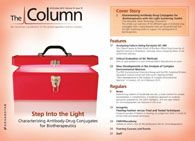Foodomics Approach Detects Anticancer Polyphenols in Rosemary
A study published in the journal Analytical Chemistry presents the application of a foodomics approach – combining transciptomics with metabolomics – to determine the anticancer mechanism of action of polyphenols contained in Rosmarinus officinalis L., commonly known as rosemary.1
Photo Credit: Creativeye99/Getty Images

A study published in the journal Analytical Chemistry presents the application of a foodomics approach — combining transciptomics with metabolomics — to determine the anticancer mechanism of action of polyphenols contained in Rosmarinus officinalis L., commonly known as rosemary.1
The major compounds in rosemary are carnosic acid (CA) and carnosol (CS) that, according to the paper, account for more than 90% of the antioxidant activity of rosemary leaves although only make up 5% of dried rosemary leaves. Corresponding author Virginia García-Cañas told The Column: “Our studies on the chemical composition indicated that the most potent extracts on inhibiting cell proliferation were richer in medium to low polarity phenolic compounds (in this instance, carnosic acid and carnosol).” She added: “In addition, carnosic acid has been the focus of different research works that have concluded that this compound may have not only anti-proliferative activities but also anti‑inflammatory properties and neuroprotective activities, besides its well‑known antioxidant capacity.”
Colon adenocarcinoma HT-29 cells were exposed to varying concentrations of rosemary extract, CA, and CS to determine the effect of treatment on cell cycle progression. Following treatment, comparative transcriptomics was performed to determine differences in gene expression dependent on treatment. Metabolic profiles were determined using capillary electrophoresis time-of-flight mass spectrometry (CE–TOF-MS) and hydrophilic interaction chromatography/ultrahigh‑performance liquid chromatography (HILIC/UHPLC–TOF-MS).
The authors found that CA activated the expression of genes encoding detoxifying enzymes and altered the expression of genes associated with the transport and biosynthesis of terpenoids. García-Cañas told The Column: “This approach provides new and unique opportunities to unravel the molecular mechanisms underlying the bioactivity of the compounds under study. Thus, foodomics helps on achieving high reliability on the results since it enables different dimensions (or levels of molecular information) of the same pathway, biological function, or process to be explored.” — B.D.
Reference
A. Valdés et al., Analytical Chemistry86, 9807–9815 (2014).
This story originally appeared in The Column. Click here to view that issue.

Determining the Link Between Prenatal Cannabis Use and Symptoms of Depression Using LC–MS/MS
April 16th 2025Researchers investigating the relationship between cannabis use during pregnancy and depressive symptoms—and whether continued use beyond the first trimester or higher levels of use were linked to increased symptoms—used liquid chromatography–tandem mass spectrometry (LC–MS/MS) to confirm the presence of 11-nor-9-carboxy-delta-9-tetrahydrocannabinol (THC-COOH) in urine samples.
A Guide to (U)HPLC Column Selection for Protein Analysis
April 16th 2025Analytical scientists are faced with the task of finding the right column from an almost unmanageable range of products. This paper focuses on columns that enable protein analysis under native conditions through size exclusion, hydrophobic interaction, and ion exchange chromatography. It will highlight the different column characteristics—pore size, particle size, base matrices, column dimensions, ligands—and which questions will help decide which columns to use.













